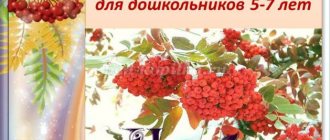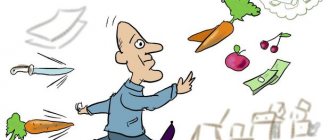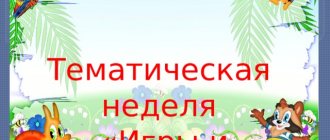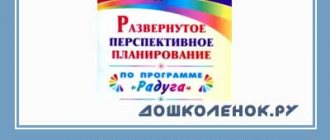Senior group. Senior preschool age. Children 5-6 years old
Long-term plan for group work on FEMP with children of older and preparatory age SEPTEMBER 1) “Help Cheburashka”
, Purpose: To train children in grouping geometric shapes.
Develop observation, attention, memory. Developmental environment: a set of logical blocks; toy "Cheburashka
"
2) "Labyrinth". Goal: To teach children to “read”
signs-symbols (signs...
Self-education plan “Development of mathematical abilities of children of senior preschool age through play activities” Self-education plan “Development of mathematical abilities of children of senior preschool age through play activities” Educator: Dotsenko T. A. Start date of work on the topic: 09/01/2022 End date: May 31, 2022 Goal: increasing your theoretical level,…
Long-term plan for the formation of elementary mathematical concepts in the senior group
Transcript
1 Appendix 1 Long-term plan for the formation of elementary mathematical concepts in the senior group during the academic year Educator: Anna Anatolyevna Klarova
2 Explanatory note The program for the formation of elementary mathematical concepts in children of the senior group of the preschool department was developed in accordance with the Federal State Educational Standard for Preschool Education (Order of the Ministry of Education and Science of the Russian Federation of October 17, 2013 1155), taking into account the approximate basic educational program “From birth to schools" edited by N.E. Veraksy, T.S. Komarova, M.A. Vasilyeva. This program was compiled using the recommendations of I.A. Pomoraeva, V.A. Pozin “Formation of elementary mathematical concepts: senior group.” — M.: MOSAIC-SYNTHESIS, The program provides for the development in children in the process of various types of activities of attention, perception, memory, thinking, imagination, speech, as well as methods of mental activity (the ability to simply compare, analyze, generalize, establish simple cause-and-effect relationships and etc.). Program goals: Formation of elementary mathematical concepts, primary ideas about the basic properties and relationships of objects in the surrounding world: shape, color, size, quantity, number, part and whole, space and time. Continue to introduce various geometric shapes, learn to use flat and three-dimensional shapes as standards. Improve your eye. Tasks on the formation of elementary mathematical concepts. Quantity and counting - Learn to create sets (groups of objects) from elements of different quality (objects of different colors, sizes, shapes, purposes; sounds, movements); to break multitudes into parts and reunite them; establish relationships between the whole set and each of its parts, understand that the set is greater than the part, and the part is less than the whole set; compare different parts of a set based on counting and correlating elements (objects) one to one; determine the larger smaller part of the set or their equality. -Learn to count to 10; consistently introduce the formation of each number in the range from 5 to 10 (on a visual basis). -Compare adjacent numbers within 10 based on comparison of specific sets; obtain equality from inequality (inequality from equality) by adding one item to a smaller quantity or removing one item from a larger quantity (“7 is less than 8, if you add one item to 7, there will be 8, equally”, “8 is more than 7; if from 8 remove one item, and there will be 7 items, equally divided"). -Develop the ability to understand the relationships of adjacent numbers (5 <6 by 1, 6>5 by 1). -Count items from a large quantity according to a pattern and a given number (within 10). -Improve the ability to count forward and backward within 10). Count objects by touch, count and reproduce the number of sounds, movements according to a pattern and a given number (within 10).
3 -Introduce numbers from 0 to 9. -Introduce ordinal counting within 10, learn to distinguish between the questions “How many?”, “Which?” (“Which one?”) and answer them correctly. -Continue to form an idea of equality: determine equal numbers in groups consisting of different subjects; correctly generalize numerical values based on counting and comparing groups (here there are cockerels, 5 nesting dolls, 5 cars, all toys are equally divided into 5). -Train children in understanding that number does not depend on the size of objects, the distance between objects, shape, their location, as well as the direction of counting (from right to left, from left to right, from any object). -Introduce the quantitative composition of numbers from units within 5 on specific material: 5 is one, one more, one more, one more and one more. Size - Learn to establish dimensional relationships between 5-10 objects of different lengths (height, width) or thickness: systematize objects, arranging them in ascending (descending) order by size; reflect in speech the order of arrangement of objects and the relationship between them in size: “The pink ribbon is the widest, the purple one is a little narrower, the red one is narrower, but it is wider than the yellow one, and the green one is narrower than the yellow one and all the other ribbons,” etc. - Compare two objects in size (length, width, height) indirectly using a third (conditional measure) equal to one of the objects being compared. -Develop the eye, the ability to find objects longer (shorter), higher (lower), wider (narrower), thicker (thinner) than the sample and equal to it. -Form the concept that an object (sheet of paper, tape, circle, square, etc.) can be divided into several equal parts (two, four). -Learn to name the parts obtained from division, compare the whole and parts, understand that the whole object is larger than each of its parts, and the part is smaller than the whole. Shape -Introduce children to the oval by comparing it with a circle and a rectangle. -Give an idea of a quadrilateral: lead to an understanding that a square and a rectangle are varieties of a quadrilateral. -Develop geometric vigilance in children: the ability to analyze and compare objects by shape, find objects of the same and different shapes in the immediate environment: books, paintings, blankets, rectangular table tops, oval trays and dishes, round plates, etc. -Develop ideas about how to make another from one form. Orientation in space
4 - Improve the ability to navigate the surrounding space; understand the meaning of spatial relationships (above below, in front (in front) behind (behind), left to right, between, next to, about); move in a given direction, changing it according to a signal, as well as in accordance with signs indicating the direction of movement (forward, backward, left, right, etc.); determine your location among surrounding people and objects. Denote the relative positions of objects in speech. Learn to navigate on a sheet of paper (right left, top bottom, middle, corner). Time orientation -Give children the idea that morning, evening, day and night make up a day. Use specific examples to clarify the sequence of various events: what happened earlier (first), what happened later (then), determine what day it is today, what it was like yesterday, what it will be like tomorrow. Types of integration of the educational area “Cognitive development” with other educational areas: “Physical development” - children develop orientation in space when performing basic movements: walking, running in different directions, drill exercises (forming in a column one at a time, in a circle; changing into a column two, three, four on the go, from one circle to several, turns right, left, around), playing outdoor games. “Artistic and aesthetic development” - develop the ability to compare objects with each other, depict objects, conveying their shape and size. “Social and communicative development”, where children apply the knowledge and skills acquired in classes in play activities. Pedagogical analysis of children's knowledge and skills is carried out 2 times a year. In mid-December in the form of diagnostic (cut-off) tasks and in April in the form of final classes. “Speech development” - children develop the ability to understand the speech of an adult without visual accompaniment; according to the teacher’s verbal instructions, find objects by color, size, shape; enrichment of the dictionary. Planned results. Identify the main parts of a group of objects, identify signs of difference and similarity, compare parts based on pairing and counting. Practice counting objects using various analyzers (by touch, by ear). Learn to compare 2 objects according to two size parameters (length and width). Learn to move in a given direction and define it in words: forward, backward, right, left. Learn to compose a set from different elements, isolate its parts, combine them into a whole set and establish a relationship between the whole and its parts. Introduce the quantitative composition of the numbers 3, 4, 5 from units. Learn to divide a circle (square, rectangle) into two equal parts, name the parts and compare the whole and the part. Learn to navigate on a sheet of paper, determine the sides, corners and middle of the sheet. Learn to count and count within 10 forwards and backwards.
5 Use cardinal and ordinal numbers correctly. Compare adjacent numbers within 10 (based on clarity, establish which number is greater (less) than another, equalize unequal groups of objects in two ways (removing and adding one). Distinguish the shape of objects: round, triangular, quadrangular. Name the parts of the day sequentially, days of the week. Name the current day of the week. Expected results: by the end of the year, children in the older group will be able to: Identify the main parts of a group of objects, identify signs of difference and similarity, compare parts based on pairing and counting. Count and count within 10 forwards and backwards order. Correctly use cardinal and ordinal numbers. Compare adjacent numbers within 10 (based on clarity, establish which number is greater (less) than another, equalize unequal groups of objects in two ways (removing and adding one). Distinguish the shape of objects: round, triangular, quadrangular. Name sequentially the parts of the day, days of the week. State the current day of the week. The basic content of the educational field of Cognition is realized in organized educational activities, the formation of elementary mathematical concepts in the amount of 32 GCD per year. GCD is held once a week, 4 months, on Tuesday, lasting 25 minutes.
6 Topic Goal Date “Counting objects within 5” Goal: consolidate counting skills within 5, the ability to form the number 5 based on comparison of two groups of objects. Be able to distinguish and name flat and three-dimensional geometric shapes. Notes 2. “Counting and counting objects” Purpose: to practice counting and counting objects within 5 (by touch, by ear). Fasten compare 2 objects by length and width “Comparing objects by size” “Comparing objects by size” Purpose: to practice comparing 5 objects by length, learn to arrange them in descending and age order, denote the results with the words: longest, shorter, even shorter, the shortest (and vice versa) “Many objects” Purpose: to learn to compose a set from different elements, select parts, combine them into a whole set. Strengthen the ability to determine spatial direction: forward, backward, left, right, above, below. 5. “Formation of the number 6” Purpose: to show the formation of the number 6 based on a comparison of two groups of objects. Develop the ability to compare up to 6 objects in length and arrange them in ascending and descending order. 6. “Formation of the number 7” Purpose: to show the formation of the number 7 based on a comparison of 2 groups of objects. Develop the ability to compare up to 6 objects in width and arrange them in descending and ascending order
7 7. “Counting objects within 6 and 7” (consolidation) Goal: continue counting within 6 and 7. Learn to answer questions correctly: “How much?”, “Which number?”, “Which place?”. Expand ideas about the activities of adults and children at different times of the day “Formation of the number 8” Purpose: to show the formation of the number 8 based on a comparison of two groups of objects. Fix the counting and counting of objects within 7 according to the model and by ear. Learn to move in a given direction (forward, backward, right, left). 9. “Number 9” Purpose: to show the formation of number 9 based on a comparison of 2 groups of objects. Fix geometric shapes (circle, square, triangle, rectangle) “Ordinal counting within 8 and 9” Purpose: to introduce the ordinal value of the numbers 8 and 9, to teach how to correctly answer the questions “How many?”, “On which count?” Exercise the ability to compare objects by size “Number 10” Purpose: to introduce the formation of the number 10. To consolidate ideas about the parts of the day and their sequence. Improve your understanding of the triangle, its properties and types. 12. “Counting by ear within 10” Goal: to strengthen counting skills by ear, to consolidate the ability to compare 8 objects in height and arrange them in descending and ascending order. 13. “Numbers 1 and 2” Purpose: to introduce numbers 1 and 2. To give an idea of a quadrilateral based on a square and a rectangle, to consolidate the ability to determine spatial direction
8 relative to another person: left, right, in front, behind. 14. “Number 3” Purpose: to consolidate counting skills within 10 (by touch), introduce the number 3, introduce the names of the days of the week “Number 4” “Compare numbers within 5” 16. “Number 5” “Compare numbers within within 8" Comparison of numbers within 5" Purpose: to learn to compare numbers and understand the relationships between them, to correctly answer the questions “How much?”, “Which number is greater?”, “How much is the number greater (less) than the number?” Introduce the number 4. Goal: continue to teach how to compare adjacent numbers and answer questions correctly. Introduce the number 5, develop the eye, the ability to find objects of the same length, equal to the “Number 6” example. Goal: introduce the number 6. Continue to develop the eye and the ability to find objects of the same width. Strengthen spatial concepts and the ability to use words: left, right, in front, behind, between, next to “Number 7”, “Comparison of groups of objects”. 19. “The composition of the number 3 from ones. Number 8" 20. "Composition of numbers 3 and 4 from ones. Number 9" Purpose: to teach how to form groups of objects according to a given number. Introduce number 7. Learn to navigate on a sheet of paper. Purpose: to introduce the quantitative composition of the number 3 from units. Introduce the number 8. Teach the ability to see the shape of familiar geometric shapes in surrounding objects: rectangle, circle, square, triangle. Purpose: to introduce the quantitative composition of 3 and 4 units. Continue learning to navigate
9 21. “The composition of the number 5 from units. Getting to know the numbers from 1 to 9" 22. "Dividing an object into 2 equal parts" (repetition of the composition of the number 5). 23. “Comparing objects using a conventional measure” 24. “Number 0. Comparing objects by length” 25. “Number 10. Dividing a circle into 2 equal parts” on a sheet of paper, determine the sides and corners of the sheet. Securely name the days of the week. Purpose: to introduce the quantitative composition of 5 of the units. Continue to introduce numbers from 1 to 9. Improve your understanding of triangles and quadrilaterals. Goal: to consolidate the idea of the composition of the number 5. To introduce counting in forward and reverse order within 5. To form the idea that an object can be divided into two equal parts, to compare the whole and the part. “Counting forward and backward within 10. Comparing objects using a conventional measure.” Goal: to consolidate the composition of a number from units. Introduce the number 0. Learn to compare up to 10 objects in length, placing them in ascending order. Goal: introduce the writing of the number 10. Continue to teach how to divide a circle into 2 equal parts. Compare 2 objects in width using the conditional measure “Dividing a square into 2 equal parts. Counting within 10" 27. "Dividing a circle into 4 equal parts" Purpose: teaches you to divide a square into 2 equal parts. Fix counting within 10, the ability to denote numbers with numbers. Goal: learn to divide a circle into 4 equal parts, compare the whole and the part. Develop the idea of the independence of number from color and spatial arrangement of objects
10 28. “Dividing a square into 4 equal parts. Comparison of objects by height." Goal: learn to divide a square into 4 equal parts. Learn to compare objects by height using a conventional measure. Consolidate knowledge of numbers from 0 to “Counting within 10”, “Neighbors of numbers from 1 to 10”. Goal: to teach to understand the relationships of adjacent numbers, to consolidate the ability to denote them with numbers. Strengthen the ability to navigate on a sheet of paper, determine the sides, angles and middle of the sheet “Comparing the size of objects by representation.” Goal: continue to learn to understand the relationships of adjacent numbers within 10. The ability to compare the size of objects according to the concept “Composition of the number 5 from ones.” Goal: improve the ability to compose the number 5 from ones. Strengthen the ability to consistently name the days of the week “Orientation on a sheet of paper” (consolidation). “Orientation on a sheet of paper - fastening. Counting within 10 (direct and reverse)."




